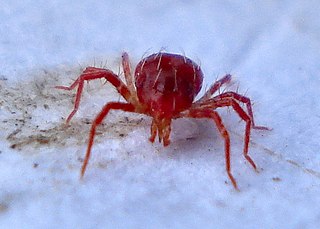Related Research Articles
The Aurantimonadaceae are a small family of marine bacteria.

Cupriavidus is a genus of bacteria that includes the former genus Wautersia. They are characterized as Gram-negative, motile, rod-shaped organisms with oxidative metabolism. They possess peritrichous flagella, are obligate aerobic organisms, and are chemoorganotrophic or chemolithotrophic. Resistance to metals has been described. These organisms have been found in both soil and in clinical isolates.
Cystobacter is a genus in the phylum Myxococcota (Bacteria).
Acidaminobacter is a genus in the phylum Bacillota (Bacteria).
Actinocatenispora is a genus in the phylum Actinomycetota (Bacteria).
Aeribacillus is a genus in the phylum Bacillota (Bacteria).
Afifella is a genus in the phylum Pseudomonadota (Bacteria). Afifella are found in marine and estuarine settings, including microbial mats. They are anaerobes, with one cultured representative capable of photosynthesis.
Daeguia is a genus in the phylum Pseudomonadota (Bacteria).
Dasania is a genus in the phylum Pseudomonadota (Bacteria).
Deefgea is a genus of bacteria in the phylum Pseudomonadota. Deefgea are described as Gram-negative, rod-shaped, facultative anaerobes which generally occur singly. Deefgea are motile, either by a single flagellum or two polar flagella. They are both catalase and oxidase positive.
Agaricicola is a genus in the phylum Pseudomonadota (Bacteria).
Akkermansia is a genus in the phylum Verrucomicrobiota (Bacteria). The genus was first proposed by Derrien et al. (2004), with the type species Akkermansia muciniphila.
Albibacter is a genus in the phylum Pseudomonadota (Bacteria).
Algibacter is a genus in the phylum Bacteroidota (Bacteria).
ï
Croceitalea is a genus in the phylum Bacteroidota (Bacteria).
Croceibacter is a genus in the phylum Bacteroidota (Bacteria).

Acaricomes phytoseiuli is a bacterium which is thought to be a pathogen of the mite Phytoseiulus persimilis. A. phytoseiuli causes a set of symptoms in the mite, known as nonresponding syndrome or NR syndrome. Dramatic changes in longevity, fecundity, and behavior are characteristic with this disease. The bacteria accumulate in the lumen of the mite's digestive tract and cause extreme degeneration of its epithelium. Infection with A. phytoseiuli greatly reduces the mite's attraction to herbivore-induced plant volatiles, and the mite is more prone to leave patches with ample prey. The disease is transmitted horizontally by means of feces and debris. The strain that was isolated was “CSC”. Differences between strain CSC compared to its closest phylogenetic neighbors are as follows: CSC uses glucose-1-phosphate and L-glutamic acid, and its colonies are more yellow in appearance as compared to its phylogenetic neighbors which are more cream/white in color.
Marichromatium is a genus in the phylum Pseudomonadota (Bacteria). The name Marichromatium derives from: Latin mare, the sea; Neo-Latin Chromatium, a genus name; to give Marichromatium, the Chromatium of the sea, the truly marine Chromatium.
Acanthopleuribacter pedis is a Gram-negative, rod-shaped bacterium found in marine environments.
References
- ↑ García-López M, Meier-Kolthoff JP, Tindall BJ, Gronow S, Woyke T, Kyrpides NC, Hahnke RL, Göker M (2019). "Analysis of 1,000 Type-Strain Genomes Improves Taxonomic Classification of Bacteroidetes". Front Microbiol. 10: 2083. doi: 10.3389/fmicb.2019.02083 . PMC 6767994 . PMID 31608019.
- ↑ Soriano S (1945). "Un nuevo orden de bacterias: Flexibacteriales" [A new order of bacteria: Flexibacteriales]. Ciencia e Investigacion (Buenos Aires). 1: 92–93.
- ↑ Euzéby JP, Parte AC. "Flexibacter". List of Prokaryotic names with Standing in Nomenclature (LPSN). Retrieved June 24, 2021.
- 1 2 Flexibacter entry in LPSN ; Euzéby, J.P. (1997). "List of Bacterial Names with Standing in Nomenclature: a folder available on the Internet". International Journal of Systematic and Evolutionary Microbiology. 47 (2): 590–2. doi: 10.1099/00207713-47-2-590 . PMID 9103655.